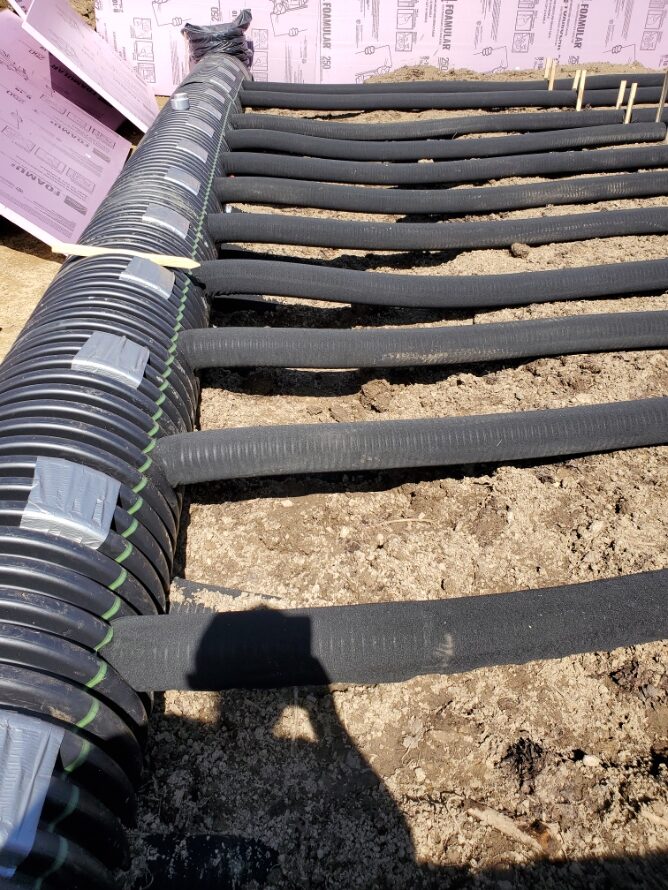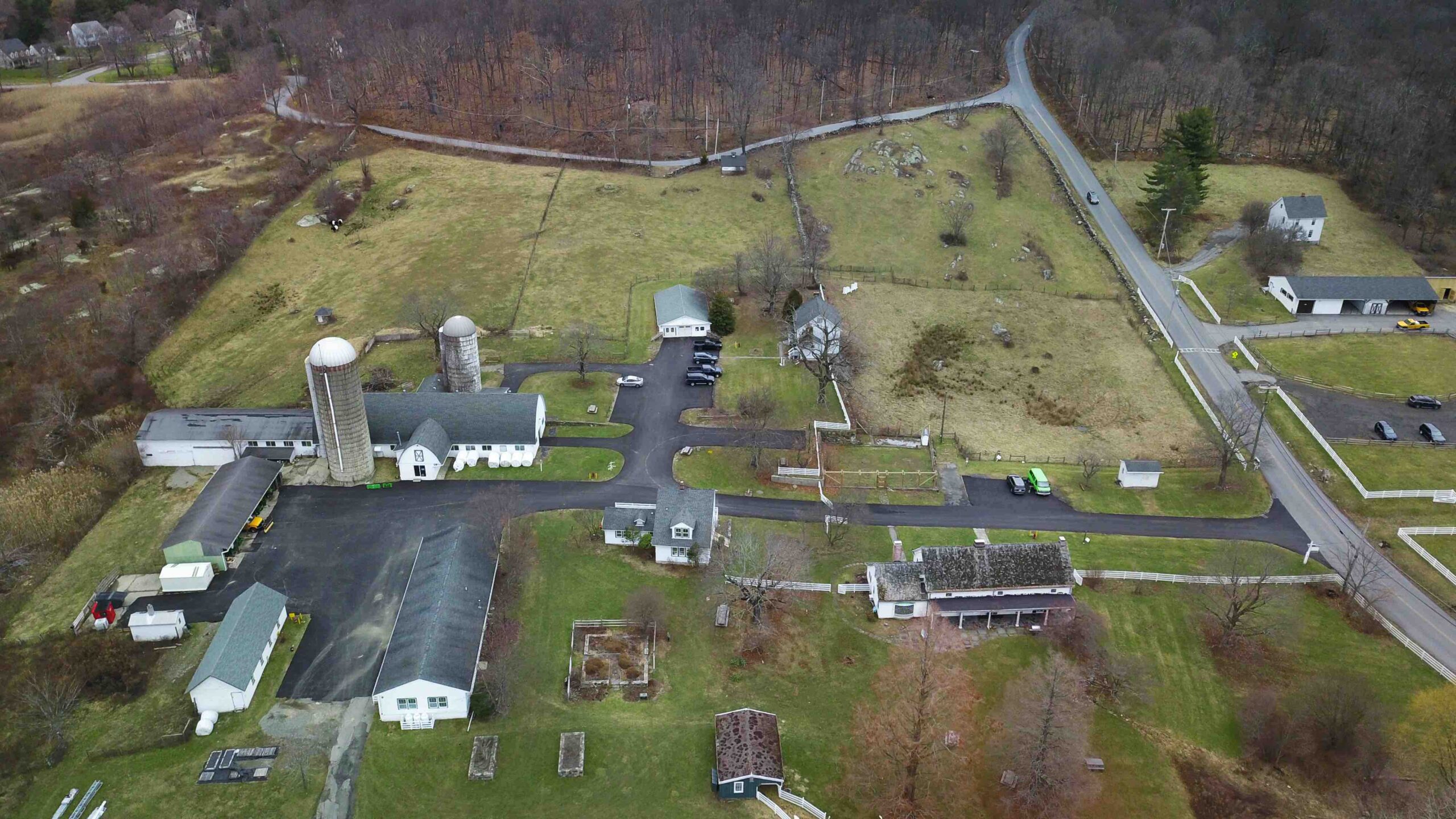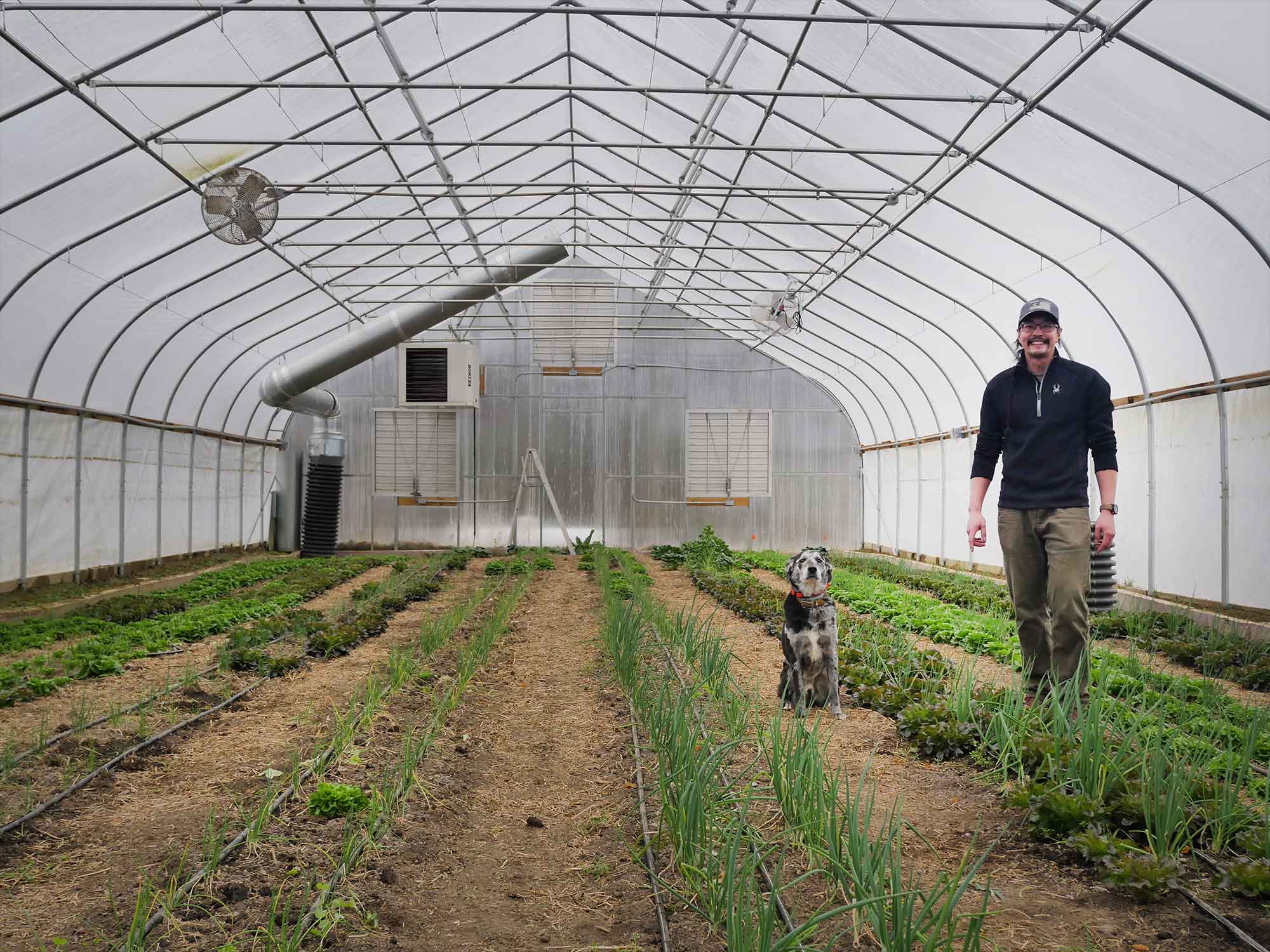Climate change, a shrinking water supply, land scarcity, invasive species, disease, trade wars, mega farms – the farming industry is simply not sustainable in its current state. Something must change. But what?
Those with their eye toward the future of farming say it’s the farmer and their practices that should change. The broad focus, they say, should center around caring for the land to improve sustainability and health.
“Agriculture is the way that humans affect the most acres, period,” says Dan Kittridge, founder and executive director of The Bionutrient Food Association and The Bionutrient Institute.
He believes that with the right strategies in place, farming can actually reverse climate change. But it would require all types of farmers throughout the world to change their practices – not just a few. And change is hard.
“It’s funny to say this is futuristic because a lot of it is sort of regressive,” says Ice Lekometros, the farm manager at Hilltop Hanover in Yorktown Heights. “We knew these practices worked, but we became really, really interested in producing more produce at a cheaper price, using less labor and caring less about the soil. That depleted our soil resources, so now we’re returning to taking care of the land.”
So, what can be done to make farming (and feeding humans) a sustainable industry? And how can we, the consumers of their products, help?
Healthy soil is essential
Soil is a living environment. It’s a complete ecosystem filled with worms, insects, fungi, bacteria and organic matter. When it’s healthy, everything works together, which benefits the plants and us.
“Soil is the bottom of the food chain,” explains Kittridge. “And only when the bottom of the food chain is healthy, can the middle of the food chain be healthy. When the middle is healthy, then the top will be healthy. We’re at the top of the food chain, so it’s in our self-interest for our soil to be healthy.”
Healthier food creates healthier humans – less illness, less disease, longer lives. But, as farmers will tell you, most of our soil isn’t healthy, and healing it requires a deep understanding of how soil works.
“To have a complex and flourishing ecosystem, there must be a balance of all the different bacteria, fungi, nematodes, arthropods and everything else,” Kittredge explains. “And there must be proper air flow and water flow. It’s all interrelated; they’re all part of the same cycle. The plants are capturing the sunlight, converting it into food and cycling with the microbes. The plants read the [soil’s] environment and ask themselves what they need to do so that everything can work better together. It’s like they’re a conductor, directing the orchestra of their microbiome – it’s a beautiful process. If the environmental conditions are maintained and there’s sufficient air, water, minerals and sunlight, then life does amazing things.”

The underground piping system for Orchard Hill Organic’s geothermal greenhouse. Photo courtesy of Wilson Chang.
Identifying healthy soil
To understand exactly what’s in their soil, farmers typically rely on soil testing, but Kittredge says you can get a pretty good idea by simply looking at and touching your soil.
“It should have the structure of chocolate cake,” he explains. “It should be fluffy with some structure. You can break it apart into little pieces, but it still holds itself together. It should be not dirt. It should be not dry. It also should not be waterlogged.”
“But it’s not the soil itself that you need to observe, it’s the whole thing,” he continues. “The soil is never separate from the ecosystem. So, what you want to see when you walk into the field is flourishing vitality. If you see bare earth, then it’s more like dirt than soil.”
Another way to tell, according to Wilson Chang, the farm manager for Orchard Hill Organics in Katonah, is the flavor of the produce. If the plant is growing in healthy soil where everything is working as it should, then it can devote it’s time and energy to non-survival activities, such as its flavor.
A third tell-tale sign: who is feasting on the plants (besides humans)?
“Insects are pests who are looking for weak plants,” says Chang. “What is a weak plant? It’s a plant that’s barely surviving, which means it’s photosynthesizing and producing a lot of simple sugars. To an insect, that’s fantastic. So, pests attack the weak plants because they’re loaded with sugars and not a lot of nutrition. But mammals, like rabbits or deer, are a lot like us. They want healthy plants with the complex flavors and nuances. The complex proteins and complex carbohydrates that are produced by healthy plants are actually a deterrent for the insect, but they add flavor and nutrition for us.”
Today, farmers with an eye towards the future are already testing their soil to determine what supplements are needed for optimum health. Some, like Chang, do it annually, while others do it less often.
Regardless of how often, testing soil requires collecting soil samples from various plots and sending them to a lab. Chang says he tests his soil around the same date, with the same weather conditions every year to get a “as similar of a snapshot as possible to best compare them, even though it’s never really comparing apples to apples.”
The results often confirm what they already know and provide specific details that guide them towards building healthier soil.
Creating healthy soil
“Everyone is focusing on soil because we know how sick our soils are,” says Lekometros. “And we know that it’s not that difficult to feed our soil and make it healthy, but it does take work.”
There are various ways to bring soil to its optimum health and maintain a proper balance, and farmers say the best ways are natural – no harmful pesticides or insecticides are needed. Kittridge relies heavily on earthworms to maintain a proper balance, while other farmers amend their soil with micronutrients and/or practice crop rotation.
Chang says he does a combination of both, and he carefully plans each step so he can determine what does and doesn’t work for his particular soil composition.
“I use things that are slow-acting, and some of them are mineral-based elemental forms of nutrients,” Chang explains. “They’re micronutrients as opposed to the macros, and when it’s in an elemental form, it takes a while to integrate into the soil biome. I’m always wary of doing too much at once. If you pull a single thread of nature, you never know exactly what the cascade will be. So typically, I do small, incremental changes over long periods of time, based on my knowledge and intuition, and then I watch how things react.”
Other farms, such as Hilltop Hanover prefer rotational cropping (growing different types of crops in a spot each year) and/or cover cropping (planting certain crops that you cannot sell but improve the health of the soil) and rarely test.
“We’re returning to intensive rotational cropping and intensive cover cropping on this farm,” says Lekometros. “We have nine acres, and about eight of them are in production from year to year. But half to one-third of those eight acres are filled with cover crops. After we’ve produced on them for about a year, we let them go fallow for a year because a lot of the diseases that affect these plants are really hard to get rid of – they’re harbored in the soil. So, if you keep coming back to the field with the same plants, they will host those diseases, spread them elsewhere and all your fields will become infected.”
“We also rotate our crops because different plants have different nutrient needs,” she continues. “For example, tomatoes are very heavy feeders. If we kept planting tomatoes on the same field, by the third or fourth or fifth year, if we don’t heavily amend the soil, we would see the results. Instead, after we’ve grown the tomatoes, we’ll plant two rounds of cover crops to replenish the soil’s nutrients.”

Microgreens grown under grow lights.
Science will play an integral role
Observing and amending soil is one indication that the future of farming will rely on scientists.
“A person needs to be naturally drawn to observation,” explains Jack Algiere, the director of agroecology at Stone Barns Center for Food & Agriculture in Pocantico Hills. “Studying the sciences will help farmers make sense of what they’re observing on a day-to-day basis. Today, agriculture schools focus on organic systems, diversification, regeneration and other scientific things.”
Chang, who studied biology with a concentration in ecology, evolution and behavior, uses his scientific background to enhance production while improving the land. During the 2022 season, Orchard Hill Organics grew 30,000 pounds of diverse produce on just 0.8 acres of land – that’s close to a pound of food per square foot. He accomplished this by carefully studying and improving the soil, intense crop rotation (four to six times per season) and gardening under 10,000 square feet of covered spaces – seven are high tunnels and one is a geothermal greenhouse that he and his team built two summers ago.
“The big challenge of a greenhouse is it’s the most effective in the spring and fall because that’s when you need the additional heat,” Chang explains. “But in the summer, they generate too much heat, so you actually have to vent it. And in the winter, the ground is too cold to grow anything, but certain crops will freeze solid, thaw and survive.”
“So, I decided to build a greenhouse geothermal system, which is different than what you would install for a house,” he continues. “This one essentially transfers energy through time. So, in the summer, when there’s excess heat, instead of venting it out of the greenhouse, we pump that hot air underground and store it in a series of pipes and manifolds that are four feet deep. We store millions of pounds of hot air, and when it gets cold, we pump that air back out under the soil. Essentially, it’s like an energy battery.”
This system allows them to grow lettuce and other cold-weather vegetables in the winter and start their tomatoes earlier in the spring. Last year, they grew 4,000 pounds of cherry tomatoes and 2,500 of heirloom tomatoes – they could’ve grown even more, but they pulled the plants to begin planting winter crops.
Chang says he believes there’s one other farm in the northeast that has a geothermal system, even though the technology was invented during the 1960s or 1970s. He reviewed blueprints for several geothermal systems and adapted them to what he needed.
At Hilltop Hanover, they’re placing an emphasis on increasing overall biodiversity.
“When we think about our crops, it’s not just about food, it’s also about planting things that provide pollination services,” Lekometros explains. “How do we integrate things that support each other? It’s not just food, it’s not just plants – it’s the integration. That includes planting some native plants that attract our local pollinators. Pollinators are losing their ability to migrate and find places to reproduce, so we’re trying to create spaces that are welcoming to different types of pollinators. We haven’t done a thorough biodiversity study yet, but it’s amazing when there’s a field of buckwheat in bloom. It’s really, really loud from all the wings flapping. You can feel it – it’s palpable. It’s really amazing.”
Two years ago, they sectioned off an area, named it The Founders Plot, and exclusively grow plants that welcome native insects. Each plot has 200 genetically diverse plants that cross-pollinate – nothing is cloned. They’re collecting all the seeds to grow and sell, hoping to create more genetically diverse plants throughout the region. If done correctly, this will increase the number of pollinators in the area which will then increase natural crop production.
“As the climate is changing, these plants are adapting,” Lekometros explains. “And they are self-selecting the best ones. We’re hoping to bridge the gap in that pollination corridor – the more native plants we can put in more farms and people’s yards, the easier it is for birds and pollinators to move. We’ve had longtime bird watchers tell us they saw a bird they never thought they’d see. It’s all because we’re growing the right foods and habitat for our pollinators.”

Hilltop Hanover sits on nine acres in Yorktown Heights.
Earning a living wage
We also need to think about the farmers – we won’t have farms (or food to eat) if there are no farmers.
“Farmers need to make a living wage so that it’s sustainable for them to continue running their business,” explains Algiere of Stone Barns Center. “This idea that each farmer is autonomously making it as a small business can only go so far.”
Algiere says for small-scale farmers to make a living wage, several things must change. He says the biggest expense on small farms is the labor, followed by overhead, which includes the equipment needed to farm the land and/or care for the animals, the infrastructure, the walk-in fridges to store freshly harvested produce, and the vehicles/items needed to take the food to market. And then there’s the cost of land, which is more expensive in Westchester, compared to upstate.
For farmers to sell their products at a competitive price, they must cut somewhere. Most of their costs are fixed, so what can they cut? Wages.
“The big challenge for farmers is that the overhead is so high,” says Chang. “And, we have a lot of bigger farms that travel down to our markets, which is fantastic, but then we’re forced to compete with these folks who are growing upstate where everything is significantly cheaper. So that’s always a challenge for us. How do we find a way to produce things that people can still afford and also remain an economically viable farm?”
“The biggest issue is that small farms and their workers are devalued by the government,” Lekometros states. “Only large farms are subsidized.”
According to the U.S. Department of Agriculture, the government plans to spend $82.12 billion in contracts and financial assistance during the 2023 fiscal year. But to Lekometros’ point, previous census data shows that over 70 percent of that money is given to farmers of corn, soybeans, wheat, cotton and rice – crops that are typically produced on the largest/richest farms and agribusinesses. And, most of these crops are grown to feed farm animals. Less than two percent goes to the fruits and vegetables we eat.
To address financial issues, Algiere and his team at Stone Barns are looking into ways that farmers can share resources to reduce costs.
“There are a lot of things we can do to have shared resources among farmers,” he says. “For example, and this is an oversimplified example, but there’s only one real outlet for our Westchester farmers to sell their goods – farmers markets. And while we have some pretty awesome farmers markets in Westchester, they’re outdoor markets, and they’re generally in commuter lots. All the farmers are friends with each other, their products are pretty much the same and they’re competing against each other in a falsely small market space. They’re not aggregated in any way. So, what if they stored their perishable items together so they could have more winter markets?”
“Or, how can we improve cooperative butcheries or infrastructure for small animal production,” he continues. “Right now, every farmer does everything themselves. They’re driving trucks to market that are a quarter full one way and empty on the way back. They’re taking a single animal at a time to a slaughterhouse that’s two hours away, and then driving back several days later to pick it up.”
“It’s extremely inefficient,” says Algiere. “There needs to be a networked infrastructure, believes. Once that infrastructure starts to return to the community, there’s a huge savings. That, to me, is a really important evolution.”

A crops farmer works the vegetable field at Stone Barns Center for Food & Agriculture. Photo by Luis Ruiz for Stone Barns Center for Food & Agriculture.
Community support
To make all of this happen, our local farms need our support. We need to buy the produce they grow, the meat they carefully raise, the seeds they sell, etc. It’s up to us to meet them, connect with them and determine how we can help.
“It takes a huge amount of work, experience and skills to be a farmer,” says Algiere. “They must understand the relationship of plants, have an artistic perspective of how to look at the landscape, understand the sciences around soil health and chemistry, know how to market their farm, and have good interpersonal skills. In the heart of a farmer, there’s a scientist, an artist, a pragmatist, a mechanic, a plant lover and an animal lover, but they also have a business. So, if we’re looking at the future of farming, part of that future includes people recognizing just how important it is to have farmers in our communities. And not as just a showpiece – farmers are a necessary piece of what it takes to have a town or a neighborhood or a region. That’s the piece that really matters.”
This article was published in the March/April 2023 print edition of Katonah Connect.
Gia Miller is an award-winning journalist and the editor-in-chief/co-publisher of Connect to Northern Westchester. She has a magazine journalism degree (yes, that's a real thing) from the University of Georgia and has written for countless national publications, ranging from SELF to The Washington Post. Gia desperately wishes schools still taught grammar. Also, she wants everyone to know they can delete the word "that" from about 90% of their sentences, and there's no such thing as "first annual." When she's not running her media empire, Gia enjoys spending quality time with friends and family, laughing at her crazy dog and listening to a good podcast. She thanks multiple alarms, fermented grapes and her amazing husband for helping her get through each day. Her love languages are food and humor.











